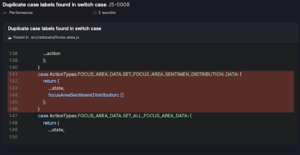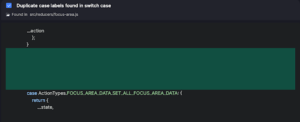The software development field is constantly evolving. Software must adhere to coding and compliance standards, should deploy on time, and be delivered to end-users quickly.
And in all these cases, mistakes are the last option for the software engineering team. Otherwise, they have to put in their energy and effort again and again.
This is how static code analysis comes to your rescue. They help development teams that are under pressure and decrease constant stress and worries.
Let’s learn more about static code analysis and its benefits:
What is static code analysis?
Static code analysis is an effective method to examine source code before executing it. It is used by software developers and quality assurance teams. It identifies potential issues, vulnerabilities, and errors and also checks whether the coding style adheres to the coding rules and guidelines of MISRA and ISO 26262.
The word ‘Static’ states that it analyses and tests applications without executing them or compromising the production systems.
Static code analysis vs. Dynamic code analysis
The major difference between static code analysis and Dynamic code analysis is that the former identifies issues before you run the program. In other words, it occurs in a non-runtime environment between the time you create and the performance unit testing.
Dynamic testing identifies issues after you run the program i.e. during unit testing. It is effective for finding subtle defects and vulnerabilities as it looks at code’s interactions with other servers, databases, and services. Dynamic code analysis catches issues that might be missed during static analysis.
Note that, the static and dynamic analysis shouldn’t be used as an alternative to each other. Development teams must optimize both and combine both methods to get effective results.
How does static code analysis work?
Static code analysis is done in the creation phase. Static code analyzer checks whether the code adheres to coding standards and best practices.
The first step is making source code files or specific codebases available to static analysis tools. Then, the compiler scans the source code and makes the program source code translate from human readability to machine code. It further breaks code into smaller pieces known as tokens.
The next stage is parsing. The tokens are taken and sequenced in a way that makes sense according to the programming language which further means using and organizing them into a structure known as Abstract Syntax Tree.
Static code analysis techniques
Data and control analysis
It helps in tracking the flow of data through the code to address potential issues such as uninitialized variables, null pointers, and data race conditions.
Control flow analysis helps to identify bugs like infinite loops and unreachable code.
Code quality analysis
It assesses the overall quality of code by examining factors like complexity, maintainability, and potential design flaws. It provides insights into potential areas of improvement that lead to more efficient and maintainable code.
Memory leak detection
Memory management that is improper can lead to memory leaks and decrease performance. It can identify areas of code that cause memory leaks. Hence, assisting developers to prevent resource leaks and enhancing application stability.
Benefits of static code analysis
Helps to identify problems in the the early stages
Effective static code analysis can detect potential issues early in the development cycle. It can catch bugs and vulnerabilities earlier that may otherwise go unnoticed until runtime. Hence, lowering the chances that crucial errors will go to the production stage leads to preventing developers from costly and time-consuming debugging efforts later.
Increases productivity
Static code analysis reduces the manual and repetitive efforts that are required for code inspection. As a result, it frees developers time to focus more on creative and complex tasks. This not only enhances developers productivity but also streamlines the development cycle process.
Code consistency and compliance
Static code analysis enforces coding protocols, ensuring development teams follow a unified coding style, coding standards, and best practices. Hence, increasing the code readability, understandability, and maintainability. Moreover, static code analysis also enforces security standards and compliance by scanning code for potential vulnerabilities.
Streamlines code refinement
With the help of static code analysis, developers can spend more time on new code and less time on existing code as they don’t have to perform a manual code review. Static code analysis identifies and alerts users to problematic code and finds vulnerabilities even in the most remote and unattended parts of the code.
Increases visibility
Static code analysis provides insights and reports on the overall health of code. This also helps in performing high-level analysis. Hence, spotting and fixing errors early, understanding code complexity and maintainability, and whether they adhere to industry coding standards and best practices.
Limitations of static code analysis
Not comprehensive in nature
Static code analysis tools have scope limitations since they can only identify issues without executing the code. Consequently, performance, security, logical vulnerabilities, and misconfigurations that might be found during execution cannot be detected through them.
False positive/negative results
Static code analysis can sometimes produce false positive/negative results. False negative occurs when vulnerabilities are discovered but not reported by the tool. Similarly, a false positive arises when new vulnerabilities in an external environment are uncovered or it has no runtime knowledge. In both cases, it leads to additional time and effort.
Lack of context
Static code analysis may miss the broader architectural and functional aspects of the code being analyzed. It can lead to false positive/negative results, as mentioned above, and also miss problematic or genuine issues due to a lack of understanding of the code’s intended behavior and usage context.
Use of AI in static code analysis
AI-powered static code analysis tools leverage artificial intelligence and machine learning to find and catch security vulnerabilities early in the application development life cycle. These AI tools can scan applications with far greater precision and accuracy than traditional queries and rule sets.
- AI static analysis tools are powerful ways to scan code faster and more efficiently. Hence, making it easier to find vulnerabilities in more complex applications.
- AI tools comprehend the context in which code is written. This makes it easier to discern false positives and negatives and provides more accurate analysis.
- One major benefit of AI static code analysis tools is that it continuously learns from the code. It then further analyses and improves their accuracy over time as they encounter new issues.
- These AI-powered tools can analyze historical code changes, and bug reports and perform data to predict potential issues or areas of code that could be prone to defects.
- AI tools can automate the code review process by analyzing code changes, pull requests, or commits in real-time.
How to implement AI-powered static analysis tools?
- Select the AI-based static analysis tool that aligns with the project’s programming languages, needs, and requirements.
- Integrate it into development workflow i.e. setting up with VCS, IDEs, or CI/CD pipelines.
- Train these tools using supervised learning techniques or labeled datasets. Make sure to train it related to specific codebase and project requirements.
- Deploy them into production and monitor their performance and effectiveness over time. Ensure it aligns with the coding standards and best practices. Don’t forget to gather feedback from your developers.
- Don’t forget to combine AI tools with human judgment to assess the tool’s recommendation and make informed decisions.
How Typo leverage AI analysis and static code analysis?
Typo’s automated code review tool not only enables developers to merge clean, secure, high-quality code, faster. It lets developers catch issues related to maintainability, readability, and potential bugs and can detect code smells. It auto-analyses your codebase and pulls requests to find issues and auto-generates fixes before you merge to master.
Typo’s Auto-Fix feature leverages GPT 3.5 Pro to generate line-by-line code snippets where the issue is detected in the codebase. This means less time reviewing and more time for important tasks. As a result, making the whole process faster and smoother.
Issue detection by Typo

Autofixing the codebase with an option to directly create a Pull Request

Key features
Supports top 10+ languages
Typo supports a variety of programming languages, including popular ones like C++, JS, Python, and Ruby, ensuring ease of use for developers working across diverse projects.
Fix every code issue
Typo understands the context of your code and quickly finds and fixes any issues accurately. Hence, empowering developers to work on software projects seamlessly and efficiently.
Efficient code optimization
Typo uses optimized practices and built-in methods spanning multiple languages. Hence, reducing code complexity and ensuring thorough quality assurance throughout the development process.
Professional coding standards
Typo standardizes code and reduces the risk of a security breach.
To learn more about Typo, do visit our website!





